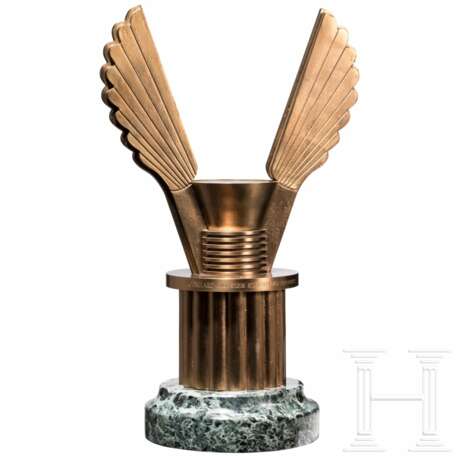"Gerhard Fieseler Kunstflug Trophäe" - Wanderpreis zur 2. Kunstflug-Veranstaltung am Flugplatz Paderborn-Haxterberg, 1984
07.11.2024 10:00UTC +01:00
Classic
Starting price
1000EUR € 1 000
| Auctioneer | Hermann Historica |
|---|---|
| Event location | Germany, Grasbrunn / München |
| Buyer Premium | 25 % |
Archive
The auction is completed. No bids can be placed anymore.

ID 1323080
Lot 2821 | "Gerhard Fieseler Kunstflug Trophäe" - Wanderpreis zur 2. Kunstflug-Veranstaltung am Flugplatz Paderborn-Haxterberg, 1984
Massiver Messingguss in Form eines Motorenzylinders mit zwei seitlichen stilisierten Flügeln. Das Unterteil in Form einer Säule mit Kapitell gestaltet, dort Widmungsumschrift "Gerhard Fieseler Kunstflug-Trophäe" und "Motiv: Der Traum wurde Wirklichkeit". Auf separatem runden Sockel aus weiß durchzogenem, gestuftem grünen Marmor. Ein Flügel mit rs. Gusslunkern. Höhe der Trophäe 56,5 cm, Breite an den Flügeln 40,5 cm. Gesamthöhe mit Sockel 64,5 cm, Gesamtgewicht 32,5 kg.
Dazu eine Widmungskarte von diesem Event an Gerhard Fieseler mit den Unterschriften teilnehmender Kunstflieger, darunter der mehrfache Kunstflug-Welt- und -Europameister Manfred Stößenreuther (1948 - 1986) und der Konstrukteur und Kunstflieger Wolfgang Dallach (1951 - 2015). 1984 gewann Stößenreuther in Anwesenheit des damals 88-jährigen Gerhard Fieseler diesen Wanderpreis vor zwei Schweizer Kunstfliegern. Vgl. auch das YouTube-Video unter https://www.youtube.com/watch?v=HohpLJjKiHc.
Gerhard Fieseler (1896 - 1987) begann seine militärische Pilotenausbildung 1915, diente in den Fliegerabt. 243 und 43 und wurde im Mai 1917 Kampfflieger bei der Jasta 25. Bis Kriegsende gelangen ihm 19 Luftsiege. In der Weimarer Republik wurde er einer der besten und innovativsten Kunstflieger, der nicht nur 1928 die deutsche Kunstflugmeisterschaft vor Ernst Udet gewann, sondern auch sein erstes Kunstflugzeug, die Fieseler F1, bauen ließ. Nach dem Erwerb des Flugzeugbauers Raab-Katzenstein begann er 1930 mit dem eigenen Flugzeugbau, ab 1939 firmierte er unter dem Namen "Gerhard-Fieseler-Flugzeugwerke". Seine sicherlich bekannteste Entwicklung ist der Fieseler Storch, weitere Modelle waren das Kampfflugzeug Fi 98 oder der Torpedo-Bomber Fi 167. Zudem baute er in Lizenz sowohl die Fw 190 als auch die Me 109 Bf 109T, die klappbare Tragflächen hatte und für den Flugzeugträger "Graf Zeppelin" bestimmt war.
Provenienz: Aus dem Nachlass des Flugzeugkonstrukteurs Gerhard Fieseler.
"Gerhard Fieseler Kunstflug Trophäe" - a challenge prize at the 2nd air acrobatics event at the Paderborn-Haxterberg airfield in 1984
"Gerhard Fieseler Kunstflug Trophäe" - a challenge prize at the 2nd air acrobatics event at the Paderborn-Haxterberg airfield in 1984
Massiver Messingguss in Form eines Motorenzylinders mit zwei seitlichen stilisierten Flügeln. Das Unterteil in Form einer Säule mit Kapitell gestaltet, dort Widmungsumschrift "Gerhard Fieseler Kunstflug-Trophäe" und "Motiv: Der Traum wurde Wirklichkeit". Auf separatem runden Sockel aus weiß durchzogenem, gestuftem grünen Marmor. Ein Flügel mit rs. Gusslunkern. Höhe der Trophäe 56,5 cm, Breite an den Flügeln 40,5 cm. Gesamthöhe mit Sockel 64,5 cm, Gesamtgewicht 32,5 kg.
Dazu eine Widmungskarte von diesem Event an Gerhard Fieseler mit den Unterschriften teilnehmender Kunstflieger, darunter der mehrfache Kunstflug-Welt- und -Europameister Manfred Stößenreuther (1948 - 1986) und der Konstrukteur und Kunstflieger Wolfgang Dallach (1951 - 2015). 1984 gewann Stößenreuther in Anwesenheit des damals 88-jährigen Gerhard Fieseler diesen Wanderpreis vor zwei Schweizer Kunstfliegern. Vgl. auch das YouTube-Video unter https://www.youtube.com/watch?v=HohpLJjKiHc.
Gerhard Fieseler (1896 - 1987) begann seine militärische Pilotenausbildung 1915, diente in den Fliegerabt. 243 und 43 und wurde im Mai 1917 Kampfflieger bei der Jasta 25. Bis Kriegsende gelangen ihm 19 Luftsiege. In der Weimarer Republik wurde er einer der besten und innovativsten Kunstflieger, der nicht nur 1928 die deutsche Kunstflugmeisterschaft vor Ernst Udet gewann, sondern auch sein erstes Kunstflugzeug, die Fieseler F1, bauen ließ. Nach dem Erwerb des Flugzeugbauers Raab-Katzenstein begann er 1930 mit dem eigenen Flugzeugbau, ab 1939 firmierte er unter dem Namen "Gerhard-Fieseler-Flugzeugwerke". Seine sicherlich bekannteste Entwicklung ist der Fieseler Storch, weitere Modelle waren das Kampfflugzeug Fi 98 oder der Torpedo-Bomber Fi 167. Zudem baute er in Lizenz sowohl die Fw 190 als auch die Me 109 Bf 109T, die klappbare Tragflächen hatte und für den Flugzeugträger "Graf Zeppelin" bestimmt war.
Provenance: Aus dem Nachlass des Flugzeugkonstrukteurs Gerhard Fieseler.
Condition: I - II
| Place of origin: | Federal Republic of Germany (1949—1990) |
|---|---|
| Auction house category: | Militaria Varies |
| Place of origin: | Federal Republic of Germany (1949—1990) |
|---|---|
| Auction house category: | Militaria Varies |
| Address of auction |
Hermann Historica Bretonischer Ring 3 85630 Grasbrunn / München Germany | ||||||||||||||
|---|---|---|---|---|---|---|---|---|---|---|---|---|---|---|---|
| Preview | |||||||||||||||
| Phone | +49 (0)89 5472 649 0 | ||||||||||||||
| Fax | +49 (0)89 5472 64999 | ||||||||||||||
| Buyer Premium | 25 % | ||||||||||||||
| Conditions of purchase | Conditions of purchase | ||||||||||||||
| Business hours | Business hours
|


